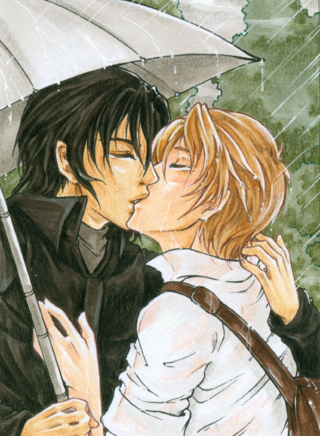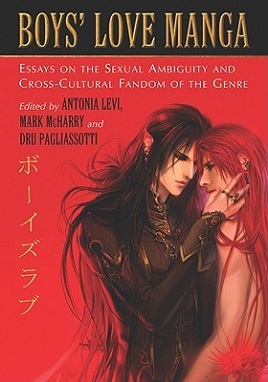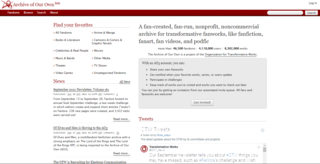Related Research Articles

Boys' love, also known by its abbreviation BL, is a genre of fictional media originating in Japan that depicts homoerotic relationships between male characters. It is typically created by women for a female audience, distinguishing it from Bara, which is homoerotic media created by and for gay men, though BL does also attract a male audience and can be produced by male creators. BL spans a wide range of media, including manga, anime, drama CDs, novels, video games, television series, films, and fan works.

Yuri, also known by the wasei-eigo construction girls' love, is a genre of Japanese media focusing on intimate relationships between female characters. While lesbian relationships are a commonly associated theme, the genre is also inclusive of works depicting emotional and spiritual relationships between women that are not necessarily romantic or sexual in nature. Yuri is most commonly associated with anime and manga, though the term has also been used to describe video games, light novels, and literature.
Slash fiction is a genre of fan fiction that focuses on romantic or sexual relationships between fictional characters of the same sex. While the term "slash" originally referred only to stories in which male characters are involved in an explicit sexual relationship as a primary plot element, it is now also used to refer to any fan story containing a romantic pairing between same-sex characters. Many fans distinguish slash with female characters as a separate genre, commonly referred to as femslash.
Femslash is a genre which focuses on romantic and/or sexual relationships between female fictional characters.

LGBT themes in speculative fiction include lesbian, gay, bisexual, or transgender (LGBTQ) themes in science fiction, fantasy, horror fiction and related genres.[a] Such elements may include an LGBT character as the protagonist or a major character, or explorations of sexuality or gender that deviate from the heteronormative.
An alternative universe is a setting for a work of fan fiction that departs from the canon of the fictional universe that the fan work is based on. For example, an AU fan fiction might imagine what would have taken place if the plot events of the source material had unfolded differently, or it might transpose the characters from the original work into a different setting to explore their lives and relationships in a different narrative context. Unlike typical fan fiction, which generally remains within the boundaries of the canon set out by the source material, alternative universe fan fiction writers explore the possibilities of pivotal changes made to characters' history, motivations, or environment, often combining material from multiple sources for inspiration. Characters' known motivations may vary considerably from their decisions in the canonical universe. The author of an alternative universe story thus can use the same characters, but send them down different paths to achieve a completely different plot.
Boys' love (BL), a genre of male-male homoerotic media originating in Japan that is created primarily by and for women, has a robust global fandom. Individuals in the BL fandom may attend conventions, maintain/post to fansites, create fanfiction/fanart, etc. In the mid-1990s, estimates of the size of the Japanese BL fandom were at 100,000 to 500,000 people. Despite increased knowledge of the genre among the general public, readership remained limited in 2008.
A Mary Sue is a type of fictional character, usually a young woman, who is portrayed as unrealistically free of weaknesses or character flaws. The term "Mary Sue" is often applied pejoratively to strong female heroines considered to be unrealistically capable, both in fan fiction and in commercially published fiction.

Fan fiction or fanfiction, also known as fan fic, fanfic, fic or FF, is fiction written in an amateur capacity by fans as a form of fan labor, unauthorized by, but based on, an existing work of fiction. The author uses copyrighted characters, settings, or other intellectual properties from the original creator(s) as a basis for their writing and can retain the original characters and settings, add their own, or both. Fan fiction ranges in length from a few sentences to novel-length and can be based on fictional and non-fictional media, including novels, movies, comics, television shows, musical groups, cartoons, anime and manga, and video games.
The role of women in speculative fiction has changed a great deal since the early to mid-20th century. There are several aspects to women's roles, including their participation as authors of speculative fiction and their role in science fiction fandom. Regarding authorship, in 1948, 10–15% of science fiction writers were female. Women's role in speculative fiction has grown since then, and in 1999, women comprised 36% of the Science Fiction and Fantasy Writers of America's professional members. Frankenstein (1818) by Mary Shelley has been called the first science fiction novel, although women wrote utopian novels even before that, with Margaret Cavendish publishing the first in the seventeenth century. Early published fantasy was written by and for any gender. However, speculative fiction, with science fiction in particular, has traditionally been viewed as a male-oriented genre.

Boys' Love Manga: Essays on the Sexual Ambiguity and Cross-Cultural Fandom of the Genre is a 2010 anthology about Boys Love (BL) and the Boys Love fandom edited by Antonia Levi, Mark McHarry, and Dru Pagliassotti.

Archive of Our Own (AO3) is a nonprofit open source repository for fanfiction and other fanworks contributed by users. The site was created in 2008 by the Organization for Transformative Works and went into open beta in 2009 and continues to be in beta. As of 24 November 2024, Archive of Our Own hosts over 14,010,000 works in over 68,550 fandoms, including those related to real people. The site has received generally positive reception for its curation, organization, and design, mostly done by readers and writers of fanfiction.
Alpha male and beta male are pseudoscientific terms for men derived from the designations of alpha and beta animals in ethology. They may also be used with other genders, such as women, or additionally use other letters of the Greek alphabet. The popularization of these terms to describe humans has been widely criticized by scientists.
Danmei is a Chinese genre of literature and other fictional media that features romantic relationships between male characters. Danmei is typically created by and targeted towards female audiences, but not necessarily straight women. While danmei works and their adaptations have achieved widespread popularity in China and globally, their legal status remains unclear due to Chinese censorship policies. The female same-gender counterpart to danmei is known as bǎihé, which is an orthographic reborrowing of the Japanese word yuri, but it is not as well known or popular as danmei.

Karen L. Hellekson is an American author and scholar who researches science fiction and fan studies. In the field of science fiction, she is known for her research on the alternate history genre, the topic of her 2001 book, The Alternate History: Refiguring Historical Time, and has also published on the author Cordwainer Smith. In fan studies, she is known for her work on fan fiction and the culture of the fan community. She has co-edited two essay collections on fan fiction with Kristina Busse, and in 2008, co-founded the academic journal, Transformative Works and Cultures, also with Busse.

Francesca Coppa is an American scholar whose research has encompassed British drama, performance studies and fan studies. In English literature, she is known for her work on the British writer Joe Orton; she edited several of his early novels and plays for their first publication in 1998–99, more than thirty years after his murder, and compiled an essay collection, Joe Orton: A Casebook (2003). She has also published on Oscar Wilde. In the fan-studies field, Coppa is known for documenting the history of media fandom and, in particular, of fanvids, a type of fan-made video. She co-founded the Organization for Transformative Works in 2007, originated the idea of interpreting fan fiction as performance, and in 2017, published the first collection of fan fiction designed for teaching purposes. As of 2021, Coppa is a professor of English at Muhlenberg College, Pennsylvania.
Fan studies is an academic discipline that analyses fans, fandoms, fan cultures and fan activities, including fanworks. It is an interdisciplinary field located at the intersection of the humanities and social sciences, which emerged in the early 1990s as a separate discipline, and draws particularly on audience studies and cultural studies.
Love Is an Illusion! is a South Korean boys' love manhwa written and illustrated by Fargo. The series has an omegaverse setting and follows Hye-sung, an Omega who thought he was an Alpha until recently, and Dojin, an Alpha who cannot stand Omegas. The series was serialized online via Lezhin Comics between January 2018 and March 2021. On February 12, 2022, a sequel, Love Is an Illusion! — The Queen, began serialization.

Welcome Home is a Japanese boy's love slice of life manga series by Ichi Ichikawa. It has been serialized in Fusion Product's Omegaverse Project anthology magazine since November 2015 and has been collected in five tankōbon volumes. The series is published in English by Manga Club. An anime television series adaptation produced by Studio Deen aired from April to June 2024.

Beginning in the mid-2010s, significant discourse emerged within fan spaces such as Tumblr and Archive of Our Own (AO3) regarding the ethical implications of portraying taboo and abusive sexual content within shipping fanfiction. "Shipping"—the depiction of a romantic or sexual relationship between fictional characters—has long been a staple within fanfiction. The lack of censorship emerging from spaces such as AO3 allowed for the portrayal of disturbing or taboo dynamics within fan works, including incest, abuse, rape, and pedophilia.
References
Citations
- 1 2 3 4 5 6 7 Alter, Alexandra (23 May 2020). "A Feud in Wolf-Kink Erotica Raises a Deep Legal Question". The New York Times. Archived from the original on 11 June 2020.
- 1 2 3 4 5 6 Valens, Ana (21 December 2020). "Welcome to the 'omegaverse,' the kinky erotica genre reimagining bodies". The Daily Dot.
- ↑ Delgado Díaz, Ubillus Breña & Cappello 2022, p. 148.
- ↑ Delgado Díaz, Ubillus Breña & Cappello 2022, p. 134.
- ↑ Algavi, Leila; Volkova, Irina; Kadyrova, Shuanatl; Rastorgueva, Natalya (2021). "Online literary creativity of digital natives: genre and thematic analysis". SHS Web of Conferences. Vol. 101, no. 3048. p. 6. doi:10.1051/shsconf/202110103048 . Retrieved 4 April 2022.
- 1 2 3 4 5 6 Popova 2018 , The Omegaverse
- 1 2 "《2019年版》おすすめオメガバースBL漫画17選【初心者向けから上級者向けまで】" [Top 17 Recommended BL Omegaverse Manga for 2019]. BookLive! (in Japanese). 11 July 2018. Retrieved 16 April 2020.
- 1 2 3 4 Quill Ink Books Limited vs Rachelle Soto A/K/A Addison Cain(United States District Court for the Eastern District of VirginiaSeptember 9, 2019), Text .
- 1 2 3 4 5 6 Fazekas 2020 , pp. 97–99
- 1 2 Busse 2013 , pp. 289–290
- 1 2 Tanjeem, Namera (18 July 2019). "The Omegaverse Plagiarism Lawsuit, One Year On". Book Riot. Retrieved 17 July 2020.
- 1 2 Shrayber, Mark (18 June 2014). "'Knotting' Is the Weird Fanfic Sex Trend That Cannot Be Unseen". Jezebel . Archived from the original on 10 March 2022. Retrieved 25 May 2020.
- ↑ "男も妊娠する世界…BLの人気設定「オメガバース」ってご存知ですか" [A world where men can get pregnant too...Do you know the popular BL setting "Omegaverse"?]. Modern Business (in Japanese). 10 July 2018. Retrieved 5 April 2022.
- ↑ "2ページ目:BLにおける「オメガバースの事情」【アニメイト編集部BL塾・応用編】 | アニメイトタイムズ" [Page 2: “Circumstances in the Omegaverse” in BL [Animate Editorial Department BL School/Advanced Edition] | Animate Times]. Animate Times (in Japanese). 6 December 2020. Retrieved 7 April 2022.
- 1 2 Sung, Morgan (26 April 2021). "What The Hell Is The Omegaverse, And Why Is It All Over TikTok?". Mashable India. Retrieved 5 April 2022.
- ↑ "傷心教師の赴任先は、妖し男子が集まる学園…羽純ハナの最新BL、ドラマCD化も決定" [The heartbroken teacher is assigned to a school where mysterious boys gather... Hazumi Hana's latest BL and drama CD also decided]. Natalie (in Japanese). 6 December 2018. Retrieved 16 April 2020.
- 1 2 Campillo Arnaiz 2018 , pp. 118–120
- ↑ Campillo Arnaiz 2018 , pp. 122–123
- ↑ Fazekas 2020 , p. 104
- 1 2 Busse 2013 , p. 294
- 1 2 3 "発情・妊娠・身分差だけじゃない!! 日本で進化中の「オメガバース」を徹底解析" [Not only estrus, pregnancy, and status difference!! A thorough analysis of the evolving "Omegaverse" in Japan]. Chil Chil (in Japanese). 3 January 2018. Archived from the original on 14 January 2021. Retrieved 4 April 2022.
- ↑ Busse 2013 , p. 290
- 1 2 3 Busse 2013 , p. 291
- ↑ Fazekas 2020 , p. 96
- ↑ Xu, Yanrui; Yang, Ling (2022). "Between BL and Slash: Danmei Fiction, Transcultural Mediation, and Changing Gender Norms in Contemporary China". In Welker, James (ed.). Queer Transfigurations: Boys Love Media in Asia. Asia Pop!. Honolulu: University of Hawaii Press. p. 25. ISBN 978-0-8248-9223-4. OCLC 1314618796.
- ↑ Delgado Díaz, Ubillus Breña & Cappello 2022, p. 139.
- ↑ Delgado Díaz, Ubillus Breña & Cappello 2022, p. 143.
- ↑ Delgado Díaz, Ubillus Breña & Cappello 2022, p. 140.
- 1 2 Delgado Díaz, Ubillus Breña & Cappello 2022, p. 141.
- ↑ Delgado Díaz, Ubillus Breña & Cappello 2022, p. 146.
- 1 2 Fathallah, Judith (8 January 2017). "The White Man at the Centre of the World: Masculinity in Sherlock". Fanfiction and the Author: How Fanfic Changes Popular Cultural Texts. Amsterdam: Amsterdam University Press. pp. 65–66. doi:10.5117/9789089649959. ISBN 978-90-485-2908-7. OCLC 1003641144. S2CID 185007623.
- 1 2 Fazekas 2020 , pp. 100–101
- ↑ Delgado Díaz, Ubillus Breña & Cappello 2022, pp. 134–135.
- ↑ Popova 2018 , Consent and the Omegaverse
- ↑ Popova 2018 , Negotiating disjunctures in sexual scripts
- ↑ Campillo Arnaiz 2018 , p. 124
- ↑ Hartenburg, Paige (2024). "Beyond the Knot: Reparative Fiction and the Omegaverse". In Tonti, Kaitlin (ed.). Fix-It Fics: Challenging the Status Quo through Fan Fiction. Vernon Press. p. 32. ISBN 9798881900021.
- ↑ Fazekas 2020 , pp. 101–102
- ↑ "Alpha/Beta/Omega Dynamics - Works | Archive of Our Own". AO3. Retrieved 17 November 2023.
- ↑ "New Omegaverse(A/B/O) Titles Coming to Renta" (Press release). Anime News Network. 22 December 2019. Retrieved 16 April 2024.
- ↑ "オメガバースといえば…"ビーボーイオメガバースコミックス"!2019年4月10日より第3期コミックス刊行開始!1作目「きみはもう噛めない」(あさじまルイ・著)は超待望の..." [Speaking of Omegaverse... "B-boy Omegaverse Comics"! The third comic will be published from April 10, 2019! The first work "You can't bite anymore" (written by Rui Asajima) is the long-awaited first comic★]. PR Times. 10 April 2019. Retrieved 6 April 2022.
- ↑ Delgado Díaz, Ubillus Breña & Cappello 2022, p. 145.
- ↑ "【作品追加】本能… 抗えない究極の主従関係! Dom/Subユニバースが話題" [[Addition of works] Instincts... The ultimate master-slave relationship that cannot be resisted! The Dom / Sub Universe is a hot topic]. Chil Chil (in Japanese). 22 January 2017. Retrieved 9 February 2022.
- ↑ "オメガに続け!?甘々、シリアスなんでもござれ「ケーキバース」とは" [Following Omega!? What is the sweet and serious "Cakeverse"]. Chil Chil (in Japanese). 3 November 2016. Retrieved 6 April 2022.
Sources
- Busse, Kristina (26 November 2013). "Pon Farr, Mpreg, and the rise of the Omegaverse". Fic: Why Fanfiction is Taking Over the World (PDF). By Jamieson, Anne. United States: Smart Pop. ISBN 978-1939529190.
- Campillo Arnaiz, Laura (2018). "When the Omega Empath Met the Alpha Doctor: An Analysis of the Alpha/Beta/Omega Dynamics in the Hannibal Fandom". The darker side of slash fan fiction: essays on power, consent and the body. By Spacey, Ashton. McFarland. pp. 116–139. ISBN 978-1-4766-7121-5. OCLC 1005299643.
- Delgado Díaz, Luz Marina; Ubillus Breña, Patricia Alexandra; Cappello, Giancarlo (30 November 2022). "Omegaverse o la forja de un universo fanfiction". Contratexto (in Spanish) (38): 129–151. doi: 10.26439/contratexto2022.n038.5911 . ISSN 1993-4904. S2CID 254147204.
- Fazekas, Angie (2020). "Alpha/Beta/Omega: Racialized Narratives and Fandom's Investment in Whiteness". Now in Color: A Collection of Voices. By Pande, Rukmini. University of Iowa Press. pp. 95–108. doi:10.2307/j.ctv193rr0q.12. ISBN 978-1-60938-728-0. JSTOR j.ctv193rr0q. S2CID 230563461.
- Popova, Milena (3 April 2018). "'Dogfuck rapeworld': Omegaverse fanfiction as a critical tool in analyzing the impact of social power structures on intimate relationships and sexual consent". Porn Studies. 5 (2): 175–191. doi:10.1080/23268743.2017.1394215. ISSN 2326-8743.